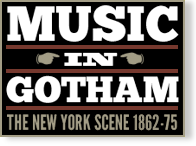Thomas Central Park Garden Concert
Event Information
Venue(s):
Central Park Garden
Proprietor / Lessee:
John Koch
Conductor(s):
Theodore Thomas [see also Thomas Orchestra]
Price: $.50; $1 & $2 extra, private boxes
Event Type:
Orchestral
Record Information
Status:
Published
Last Updated:
2 July 2025
Performance Date(s) and Time(s)
17 Jun 1875, 8:00 PMPerformers and/or Works Performed
Citations
Includes a descriptive analysis of Liszt’s Rhapsodie hongroise.
“Notwithstanding the bad weather, there was a large audience at the Central Park Garden on Thursday, when the following programme was offered [see above].
The symphony, we believe, has never been played in New-York, and it is probably not well known anywhere, for neither of Weber’s two compositions in this class can be said to have won a place in the standard repertory of the orchestra. It was highly interesting, however, to listen to such a production from the pen of this most romantic of musicians, who has betrayed in his operas, both by his treatment of melodies and his handling of the orchestra, so many of the qualities of a fine symphonist. We can trace here the strongest characteristics of his dramatic style, the ingenious use of comparatively simple melodies, and the free expression of sentiment. In the Allegro the clear cut tune recurs again and again with the regularity of a refrain; in the Andante we abandon formal models and give loose rein to the poetic impulse. This second movement, and the bright and effective Scherzo, were favorites with the composer himself. All the movements, however, though not remarkable for any broad development of their themes, contain passages of great beauty. The instrumental coloring, of course, is always charming, notwithstanding the simplicity of the means by which it is produced. Only one flute is employed, and there are no clarinets.
The Hungarian Rhapsody which figures as No. 3 in the orchestral arrangement by Liszt and Doppler is No. 6 in the original piano-forte series—the same which Rubinstein played during his last recitals in New-York. Here we have all the resources of the modern orchestra brought into play, for besides the customary instruments—piccolo, flutes, reeds, horns, trumpets, trombones, timpani, and strings—the score provides for an ophecleide (doubling the bass trombone), triangle, cymbals, harp, bass drum, tambourine, and the curious Hungarian cimbalom, which was heard here recently at a concert of the Gypsy band in Steinway Hall. This semi-barbarous contrivance consists of a sort of large but shallow box, like a [illegible] zither, with wire strings which the player strikes with little hammers. The ingenuity of Mr. Theodore Steinway has supplied a capital substitute for this device, being in brief a small piano with the hammers [wrapped?] in wire which imitates very closely the incisive tone and sharp metallic twang peculiar to the original. We can hardly exaggerate the striking effect produced by the introduction of this strange wild instrument in the midst of the full orchestra. It is first noticed in the second part of the rhapsody, where it furnishes with the harp an accompaniment to a charming solo (andante) for the clarinet, and thence to the end it is frequently used in the most brilliant manner. The whole work is fascinating, with melodies of the fiery Hungarian type, ear-catching rhythms, and a superb instrumentation. It has captivated the public more completely than any other novelty of the season.”

